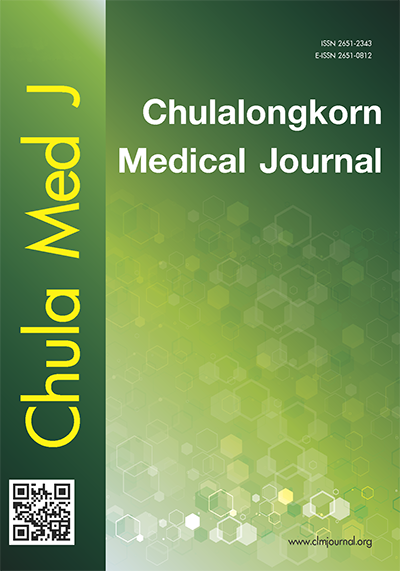Effectiveness of rehabilitation programs for shoulder pain at King Chulalongkorn Memorial Hospital
Keywords:
Shoulder painAbstract
Objective : To study demographic data, diagnosis, treatment program and success rate of rehabilitation program for shoulder pain patient and identify factors associated with more than 50% improvement of clinical symptoms.
Study Design : Retrospective descriptive and case-control study.
Setting : Department of Rehabilitation Medicine, King Chulalongkorn Memorial Hospital.
Material and Method : All intra-department medical records of patients January 2004 to December 2007 were reviewed. Records of patients with shoulder pain who were prescribed physical therapy programs would be included into the study. Data related to physical therapy programs and durations of treatment were reviewed. Furthermore, their outpatient medical data recorded by physiatrists including demographic data, diagnosis, underlying diseases, other intervention, medication and the improvement of the clinical symptoms were also analyzed.
Result : Three hundred and seventy-eight patients were included into the study. There were 98 males (25.9%) and 280 (74.1%) females, with the mean age of 55.29 ± 12.30 years and the highest frequency in the age category of 41-60 years old. Diabetes mellitus (26.1%) and cervical spondylosis (18.1%) were the common underlying diseases. Frozen shoulder or shoulder capsulitis was the most frequently recorded disorder (56.6%); followed by myofascial pain syndrome (15.1%), supraspinatus tendonitis (9.3%), impingement syndrome (8.7%) and bicipital tendinitis (6.9%), respectively. The treatment programs included physical modalities (96.6%), range of motion and stretching exercise with joint mobilization (73.8%), medication (65.1%), local injection (7.4%) and dry needling (3.4%). Treatment outcomes were categorized as “resolved” (10.1%), “more than 50% improvement” (79.6%), “less than 50% improvement “ (9.3%) and “not improved” (1%). Cervical spondylosis was the only factor that had a tendency to has a negative affect for clinical improvement (adjusted OR = 2.5 : 95% CI= 0.99 - 6.33).
Conclusion : Female patients, aged from 41 to 60 years old, with underlying disease of diabetes mellitus had the highest prevalence of shoulder pain. More than half were diagnosed as frozen shoulder or shoulder capsulitis. Addition to physiotherapy method, the other procedures such as local injection and dry needling were also used. Ten percent and ninety-percent of the patients had their symptom completely resolved and more than 50% improved, respectively. Cervical spondylosis has a tendency to associated with clinical improvement in a negative way, although it was not statistically significant.
Downloads
Downloads
Published
How to Cite
Issue
Section
License
Copyright (c) 2023 Chulalongkorn Medical Journal

This work is licensed under a Creative Commons Attribution-NonCommercial-NoDerivatives 4.0 International License.










